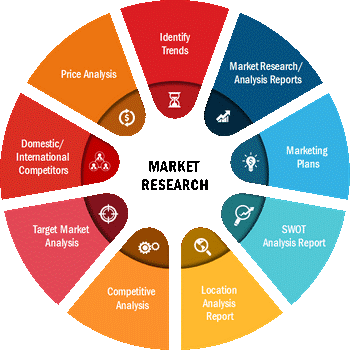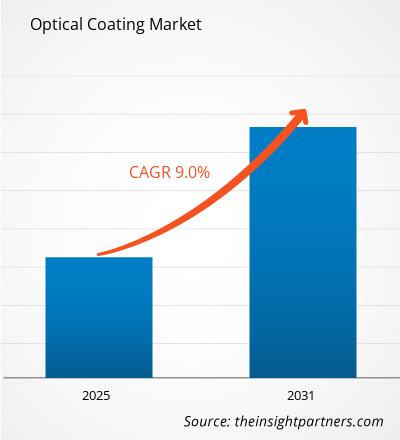光学镀膜市场预计将从 2022 年的 133.8 亿美元增长到 22.40 美元到 2031 年将达到 10 亿,预计 2022 年至 2031 年复合年增长率为 9.0%。
光学镀膜由薄膜层组合而成,可产生干涉效应,以增强光学系统内的透射或反射性能。光学涂层由金属、稀土材料或氧化物等材料的薄层混合物组成。光学涂层的性能取决于层数、各层的厚度以及层界面处的折射率差。它们几乎是所有光学仪器中不可或缺的一部分,从眼镜和望远镜到简单或复杂的镜子。
市场动态
使用光学涂层在许多电子应用中,光必须穿过光学表面。光学抗反射涂层用于平板电脑和手机屏幕,具有多种用途,包括使文本在日光下更易于阅读。这些涂层用于半导体二极管激光器的端面。由于物联网 (IoT) 在各行各业中变得越来越普遍,近年来对半导体的需求激增。这些因素正在推动光学镀膜市场的增长。
市场范围
《2031年全球光学涂料市场分析》是一份专业、深入的报告研究光学镀膜市场,特别关注全球市场趋势分析。该报告旨在提供光学镀膜市场的概况以及详细的市场细分。它提供了有关领先市场参与者状况的关键统计数据,并提供了市场的主要趋势和机会。
战略洞察
市场细分
全球光学涂料市场分为类型、技术和最终用途行业。根据类型,市场分为抗反射、高反射、透明导电、滤光片、分束器、电致变色等。从技术角度来看,市场分为真空沉积技术、电子束蒸发技术、溅射技术等。根据最终用途行业,市场分为电子和医疗设备。半导体、军事和国防、汽车、太阳能、医疗、消费品等。
全球光学镀膜市场分为北美、欧洲、亚太地区 (APAC)、中东和非洲五个主要区域。非洲 (MEA) 和南美洲中美洲。该报告涵盖了对全球 18 个国家的分析和预测,以及这些地区当前的趋势和机遇。
亚太地区在 2021 年光学镀膜市场占据主导地位。该地区市场的增长主要受到电子和工业领域需求增长的推动。 许多亚洲国家已开始采取措施促进半导体、太阳能和国防领域的增长。电子行业。 例如,印度正在推动汽车、半导体和航空航天产品的“印度制造”计划。这一举措将有利于该国生产汽车玻璃板、太阳能电池板、光电元件和其他电子设备的能力。因此,亚太地区各国政府的此类举措促进了电子和工业的发展。半导体制造业,在光学镀膜市场占据主导地位。
资料来源:Insight Partners 分析
报告分析了驱动因素、限制因素、机会和未来等因素趋势,影响光学涂料市场。它还提供了详尽的波特五力分析,突出了影响这些地区市场的因素。
COVID-19 大流行的影响
COVID-19 大流行严重影响了许多行业。封锁的实施暂时停止了各种制造活动,导致供应减少,这对光学涂料市场产生了重大影响。运输、制造、石油和天然气、汽车和能源行业长期停产,导致全球光学涂料需求大幅下降。电子产品和半导体行业由于依赖受到严重打击的中国和其他亚洲国家,是受到严重影响的行业之一。该行业的消费电子、消费品和汽车等细分市场面临高风险。相比之下,包括云计算数据中心、通信和数据中心在内的其他领域。连接技术和医疗保健未受影响。 然而,疫情期间,医疗器械的需求增加,从而增加了对光学镀膜的需求。
此外,各经济体在 2021 年开始恢复运营。5G 的采用日益普及技术正在增加对 5G 调制解调器、5G 路由器、MIMO 天线、5G 新无线电 (5GNR)、C-RAN 单元、多通道高度集成等电子设备的需求 RF 收发器 和压控晶体振荡器 (VCXO)。此外,对增强内存和存储的需求预计将增加对微芯片的需求。这为半导体企业带来了前所未有的机遇。因此,电子产品和设备的需求不断增加。半导体行业预计将推动光学镀膜市场的增长。此外,汽车产量的增加,太阳能、医疗和消费品行业预计将为光学镀膜创造机会。< /span>
市场参与者
这些报告涵盖了光学涂料市场有机和无机增长战略的主要发展。许多公司都专注于有机增长战略,例如产品发布、产品批准、专利和活动。市场上出现的无机增长战略活动包括收购、伙伴关系和合作。这些活动为业务扩展和市场参与者的客户群铺平了道路。由于对光学镀膜的需求不断增长,预计市场参与者在未来几年将获得利润丰厚的增长机会。
该报告包括光学镀膜市场上主要公司的概况,以及他们的 SWOT 分析和市场策略。它还重点关注领先的行业参与者的信息,例如公司简介、提供的组件和服务、过去三年的财务信息以及过去五年的主要发展。
光学涂料市场的主要公司
- 杜邦de Nemours, Inc.
- PPG Industries, Inc.
- 日本电气硝子株式会社
- 雷纳德公司
- Abrisa Technologies
- Alluxa, Inc
- Artemis Optical Ltd.
- Cascade Optical Corporation
- 致茂科技股份有限公司
- Coherent Corp.
Insight Partner 的专业研究和分析团队由经验丰富的专业人士组成,拥有先进的统计专业知识,并在现有研究中提供各种定制选项。

- 历史分析(2 年)、基准年、预测(7 年)及复合年增长率
- PEST 和 SWOT 分析
- 市场规模价值/数量 - 全球、区域、国家
- 行业和竞争格局
- Excel 数据集


- Sports Technology Market
- Medical Enzyme Technology Market
- Single Pair Ethernet Market
- Dealer Management System Market
- Water Pipeline Leak Detection System Market
- Retinal Imaging Devices Market
- Electronic Signature Software Market
- Single-Use Negative Pressure Wound Therapy Devices Market
- Artificial Intelligence in Healthcare Diagnosis Market
- Fill Finish Manufacturing Market

Report Coverage
Revenue forecast, Company Analysis, Industry landscape, Growth factors, and Trends

Segment Covered
This text is related
to segments covered.

Regional Scope
North America, Europe, Asia Pacific, Middle East & Africa, South & Central America

Country Scope
This text is related
to country scope.
Trends and growth analysis reports related to Chemicals and Materials : READ MORE..
The List of Companies
1. Abrisa Technologies
2. Alluxa
3. Artemis Optical Ltd.
4. Cascade Optical Corporation
5. Chroma Technology Corporation
6. II-VI Optical Systems
7. Inrad Optics
8. Reynard Corporation
9. SCHOTT AG
10. VIAVI Solutions Inc.
The Insight Partners performs research in 4 major stages: Data Collection & Secondary Research, Primary Research, Data Analysis and Data Triangulation & Final Review.
- Data Collection and Secondary Research:
As a market research and consulting firm operating from a decade, we have published and advised several client across the globe. First step for any study will start with an assessment of currently available data and insights from existing reports. Further, historical and current market information is collected from Investor Presentations, Annual Reports, SEC Filings, etc., and other information related to company’s performance and market positioning are gathered from Paid Databases (Factiva, Hoovers, and Reuters) and various other publications available in public domain.
Several associations trade associates, technical forums, institutes, societies and organization are accessed to gain technical as well as market related insights through their publications such as research papers, blogs and press releases related to the studies are referred to get cues about the market. Further, white papers, journals, magazines, and other news articles published in last 3 years are scrutinized and analyzed to understand the current market trends.
- Primary Research:
The primarily interview analysis comprise of data obtained from industry participants interview and answers to survey questions gathered by in-house primary team.
For primary research, interviews are conducted with industry experts/CEOs/Marketing Managers/VPs/Subject Matter Experts from both demand and supply side to get a 360-degree view of the market. The primary team conducts several interviews based on the complexity of the markets to understand the various market trends and dynamics which makes research more credible and precise.
A typical research interview fulfils the following functions:
- Provides first-hand information on the market size, market trends, growth trends, competitive landscape, and outlook
- Validates and strengthens in-house secondary research findings
- Develops the analysis team’s expertise and market understanding
Primary research involves email interactions and telephone interviews for each market, category, segment, and sub-segment across geographies. The participants who typically take part in such a process include, but are not limited to:
- Industry participants: VPs, business development managers, market intelligence managers and national sales managers
- Outside experts: Valuation experts, research analysts and key opinion leaders specializing in the electronics and semiconductor industry.
Below is the breakup of our primary respondents by company, designation, and region:

Once we receive the confirmation from primary research sources or primary respondents, we finalize the base year market estimation and forecast the data as per the macroeconomic and microeconomic factors assessed during data collection.
- Data Analysis:
Once data is validated through both secondary as well as primary respondents, we finalize the market estimations by hypothesis formulation and factor analysis at regional and country level.
- Macro-Economic Factor Analysis:
We analyse macroeconomic indicators such the gross domestic product (GDP), increase in the demand for goods and services across industries, technological advancement, regional economic growth, governmental policies, the influence of COVID-19, PEST analysis, and other aspects. This analysis aids in setting benchmarks for various nations/regions and approximating market splits. Additionally, the general trend of the aforementioned components aid in determining the market's development possibilities.
- Country Level Data:
Various factors that are especially aligned to the country are taken into account to determine the market size for a certain area and country, including the presence of vendors, such as headquarters and offices, the country's GDP, demand patterns, and industry growth. To comprehend the market dynamics for the nation, a number of growth variables, inhibitors, application areas, and current market trends are researched. The aforementioned elements aid in determining the country's overall market's growth potential.
- Company Profile:
The “Table of Contents” is formulated by listing and analyzing more than 25 - 30 companies operating in the market ecosystem across geographies. However, we profile only 10 companies as a standard practice in our syndicate reports. These 10 companies comprise leading, emerging, and regional players. Nonetheless, our analysis is not restricted to the 10 listed companies, we also analyze other companies present in the market to develop a holistic view and understand the prevailing trends. The “Company Profiles” section in the report covers key facts, business description, products & services, financial information, SWOT analysis, and key developments. The financial information presented is extracted from the annual reports and official documents of the publicly listed companies. Upon collecting the information for the sections of respective companies, we verify them via various primary sources and then compile the data in respective company profiles. The company level information helps us in deriving the base number as well as in forecasting the market size.
- Developing Base Number:
Aggregation of sales statistics (2020-2022) and macro-economic factor, and other secondary and primary research insights are utilized to arrive at base number and related market shares for 2022. The data gaps are identified in this step and relevant market data is analyzed, collected from paid primary interviews or databases. On finalizing the base year market size, forecasts are developed on the basis of macro-economic, industry and market growth factors and company level analysis.
- Data Triangulation and Final Review:
The market findings and base year market size calculations are validated from supply as well as demand side. Demand side validations are based on macro-economic factor analysis and benchmarks for respective regions and countries. In case of supply side validations, revenues of major companies are estimated (in case not available) based on industry benchmark, approximate number of employees, product portfolio, and primary interviews revenues are gathered. Further revenue from target product/service segment is assessed to avoid overshooting of market statistics. In case of heavy deviations between supply and demand side values, all thes steps are repeated to achieve synchronization.
We follow an iterative model, wherein we share our research findings with Subject Matter Experts (SME’s) and Key Opinion Leaders (KOLs) until consensus view of the market is not formulated – this model negates any drastic deviation in the opinions of experts. Only validated and universally acceptable research findings are quoted in our reports.
We have important check points that we use to validate our research findings – which we call – data triangulation, where we validate the information, we generate from secondary sources with primary interviews and then we re-validate with our internal data bases and Subject matter experts. This comprehensive model enables us to deliver high quality, reliable data in shortest possible time.

 获取此报告的免费样本
获取此报告的免费样本